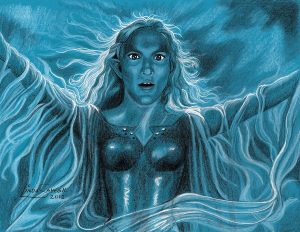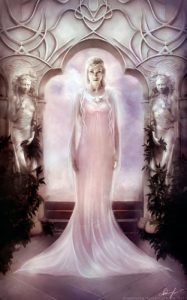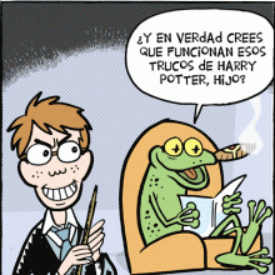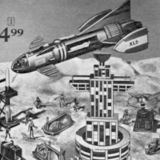Well it looks like I put my foot right into it in my previous post! Several people objected to my definition of the term “Fan Art”. They felt that it was not in accordance with how “Fan Art” has historically been defined and used within Fandom, and how it is still defined with regard to the Hugos.
I understand that the “Best Fan Artist” category of the Hugos applies to the medium of distribution – according to this definition, a “Fan Artist” is “an artist or cartoonist whose work has appeared through publication in semiprozines or fanzines or through other public display during the previous calendar year.”
“Fanzines and semi-prozines are further defined in other parts of the WSFS Constitution. Those publication types are in turn defined by the word “professional,” which is pinned down at Section 3.2.11:
3.2.11: A Professional Publication is one which meets at least one of the following two criteria:
(1) it provided at least a quarter the income of any one person or,
(2) was owned or published by any entity which provided at least a quarter the income of any of its staff and/or owner.”
(thanks to Kevin Standlee for providing the official definition)
First of all, this is a definition which seems to apply to the ARTIST and her or his degree of “professionalism” – a term which, in theory, is simply a statement of economic facts, but is often perceived to also imply a value judgment. It is not a term which applies to an ARTWORK, or defines an artistic GENRE.
This may be a useful distinction for the purposes of an award – along the same lines as say, age groupings for a sports award – but for the purposes of art criticism, it is not a useful definition.
I find most of the images I will feature here on the internet – generally on the artist’s own portfolio websites or in their self-managed online galleries. Medium of publication, whether “professional” or not, does not even enter the equation. To determine whether an image is “Fan Art” according to the ancient time honoured definition of the term, I would have to determine *if*, and *where*, each image was published, and what percentage of their income the publisher derives from the publication – and I would have to rewrite my blog each time someone sells a previously unpublished work to a “proper professional” outlet. Not very practicable!
Many of the artists I intend to feature here are actively in the process of building a professional career – as in, providing a substantial portion of their income – but haven’t quite got there yet. In fact, I am writing this blog with the explicit hope of giving some of those people some all-important “exposure” which may help them along in this process, and help build their self-confidence at the same time (you’d be surprised how many very fine artists think they are entirely not good enough, because they’re always being told they’re not “professional”).
It would be doing these artists a disservice, and run completely counter to what I wish to achieve here, if I put all of them into a box which is labeled, a priori and by definition, “not professional art”. If we are speaking of love and generosity, well, this is how I express mine : to offer my time and expertise to (hopefully) give others a nudge out of the door, or along the path, to help them achieve their dream.
Besides. These days, with the emergence of E-publishing, and the increasingly large percentage of people who choose to self-publish their work, the distinction between what is “amateur’ and what is “professional” is becoming more and more fluid and blurry. In the old days, one needed the official stamp of approval from a publisher or an agent or another such entity, to call oneself professional. These days, if someone buys your stuff, then you’re in! For better or worse, we’ve largely done away with gatekeeperism. Personally, I think this is mostly a good thing.
For all these reasons, I prefer to use genre definitions which are intrinsic to the artwork itself, rather than defined by an outside factor such as medium of publication, or “professionalism” – real or perceived. I have outlined those genre definitions in my previous blog post: mainly, I will be talking about Fantasy Art, Science Fiction Art, Illustration, Concept Art for games and movies, and Fan Art, with a dash of Comic Art and Manga.
Fan Art, in this context, refers to “art derived from visual media such as comics, movies, television shows or video games.” This is in accordance with the second of the two definitions cited on Wikipedia. It is also in accordance with how I have always known the term to be used within the visual arts community, and it is a far more useful definition for the purposes of this blog. Everyone who wishes is of course entitled to continue using the term in the old traditional sense! I am not trying to rename the Hugos. But I also appreciate if people accept that language evolves, and a word can mean different things to different people.
I should also point out that the newer definition actually does relate back to the old one: Of all the artistic genres I plan to discuss here, Fan Art is the only genre which is, by necessity, restricted to the non-professional sector (unless it is licensed or commissioned commercial art), simply because of the current state of Intellectual Property legislation, which I have also touched upon in my previous blog post. The terms “copyright infringement” and “derivative”, which some people have objected to, are legal terms – they imply a value judgement only if one is of the conviction that “original” art is by definition better. I think this would discount large portions of the history of the art of painting.
Copying the “old masters” is a time honoured way of learning one’s craft as a painter, which is far more ancient than Fandom and its particular traditions. Some of the artists working in this genre create work on a very high technical and interpretative level, which reflects the fact that popular movies, games and cartoons have become as much part of our visual furniture, these days, as landscapes were for the Romantics, or Still Lives for the “Old Masters”. One can only hope that some day, copyright and trademark legislation will reflect this fact.
I’ve been rattling on for rather a bit longer than the average blog post is meant to be, in order to address the lively discussion which has taken place, but I would like to continue with the original 2nd part of this article:
To illustrate the difference I perceive between “Fan Art” and other genres, in particular Illustration – and to show off the fuzziness of the grey areas! – here are a few depictions of Tolkien’s Lady Galadriel, which I found on DeviantArt:

At the one extreme, here is an image which clearly violates several copyrights: the use of an actual screen shot, the inclusion of the inscription on the One Ring , the inclusion of the word “Hobbit”, and the use of the font from the film titles. Definitely not viable in a commercial context, and not even in a non-commercial context if the artist was claiming it as their own work. However, since the image is clearly marked as “Fan Art” and as a design exercise, it can be seen to be done in an “educational context”. Just in case, I will refrain from linking this image back to the original on DeviantArt. 🙂



These three images are renderings of screen shots from the movie, and thus what I call “Fan Art”. While they do not violate copyright in the sense that they include an actual screen shot from the movie, they are close enough renderings of individual shots from the movie, to be seen as derivative, rather than original artworks. They are technically skillful, and in the third one particularly, the artist has put her own spin on the iconic scene from the movie – it is a very “painterly” interpretation. They are all perfectly legitimate in a non commercial context, but would require licensing if the artist was to commercialize them.


These two images are both skillful renderings of the same screenshot, but while the first one painstakingly reproduces details from the movie interpretation of Galadriel (the head ornament, the starry light in the pupils), the second one comes across more as a beautiful portrait, based on a reference image. Perhaps leaving out a detail like a piece of jewelry, and changing the lighting just a bit, sometimes makes all the difference between a derivative image, and one that comes across as more of an individual creative effort? This assessment is, of course, entirely subjective! Still, both artist would presumably require permission or a license, to publish those images.



Three more images which, while being based on a screen shot from one of the movies, are treated more freely, and transmit something of the artist’s own interpretation of the character, rather than a painstaking copy of someone else’s. I would consider them to straddle the borderline between Fan Art, Portraiture, and Illustration.


Moving on to Illustration: these are two interpretations of the same scene by the same artist. The artist herself calls the first one “Fan Art”, but by my own definition, I would consider this to be an illustration, even though it shows influences from the movie in the style of the jewelry and costumes, the shape of the basin, those bright blue hobbit eyes, and the fact that it is only Frodo who looks into the mirror (in the book, don’t forget, Frodo and Sam both get a look). And the shape of the silver water pitcher. But the faces of the characters, their postures, and the background, are very clearly the artist’s own interpretation, and not derived from those of the actors in the movie.


Two more portraits of Galadriel: one in the style of Mucha, the other in a vaguely Chinese style. The only influence from the movie I can discover is, again, the shape of that silver water pitcher – especially in the first image. That water pitcher is a winning feature, hands down! 😀



Three illustrations which owe nothing to the movies. The first one is also derivative in the sense that it is based on a famous medieval tapestry, “The Lady and the Unicorn”, but since the original image is in the public domain, there is no restriction to commercializing it. It is also proof that “derivative” does not necessarily imply “uninspired” or “dumb” – I think this is a pretty cool crossover between medieval imagery and modern computer art!
I do have to admit that in my own interpretation, the mallorn trees look suspiciously like southern beech trees — and if I’d never seen those movies, and never moved to New Zealand, I am pretty sure my mallorns would have looked like linden trees. It is hard to entirely ignore the imagery of the movie version!

And now on to something completely different … but this type of image, the visual arts version of “Slash”, probably merits a blog post of its own!
All images are copyright the respective artist, and may not be reproduced elsewhere without permission.
Disclaimer: while I have a working knowledge of copyright and trademark legislation, I am not a lawyer, and this article should not be taken as legal advice. If you need individual advice on any of these matters, please seek out a legal professional.










